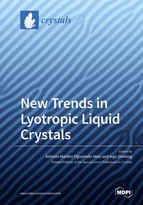New Trends in Lyotropic Liquid Crystals
A special issue of Crystals (ISSN 2073-4352). This special issue belongs to the section "Liquid Crystals".
Deadline for manuscript submissions: closed (30 June 2020) | Viewed by 56345
Special Issue Editors
Interests: magnetic colloids; lyotropic liquid crystals; low-density lipoproteins; nonlinear optical properties; structure of mesophases
Interests: liquid crystals; chiral liquid crystals; ferroelectric liquid crystals; polymer stabilized liquid crystals; nanoparticles in anisotropic fluids; liquid crystal-nanotube dispersions; defects and defect dynamics; phase ordering in soft matter; fractal structures
Special Issues, Collections and Topics in MDPI journals
Special Issue Information
Dear colleagues,
The liquid crystalline state of matter has been investigated for more than 100 years by many researchers from different branches of science, technology, and even the arts. Materials presenting liquid crystal properties are present in our daily lives (e.g., cell phones, watches, thermometers, and displays). The great majority of these materials belong to the family of thermotropic liquid crystals. Liquid crystalline properties are also present in mixtures of amphiphilic molecules and solvents, or shape-anisotropic colloids in solvents, which constitute the family of lyotropic liquid crystals. These have attracted a great deal of interest in recent years, despite the fact that technological applications of these materials are not widespread. Some outstanding aspects make lyotropics very attractive for research: The richness of their phase diagrams, showing structures not present in thermotropics; Their closeness with biological systems (e.g., the cell membrane structure); The kosmotropic and chaotropic (bonding/order inducing and disrupting) characteristic of the chemical groups present in some molecules forming lyotropics give interesting information about the water arrangement (solvation water) at the solute/solvent interface; and the possibility of exploiting their self-organization in nanotechnology, as templates. Recently, new mixtures have been proposed, enlarging the possibility of new structures and exciting new properties. It is expected that in the near future, research in lyotropics will increasingly impact biology and medicine—in particular in the field of drug delivery with low toxicity, membrane permeation, and elasticity.
We invite colleagues to submit papers exploring the different aspects of the physico-chemical properties of lyotropic liquid crystals.
The potential topics include, but are not limited to:
- New lyotropic mixtures
- Property characterization (structure, linear and nonlinear optics, etc.)
- Chromonic lyotropic liquid crystals
- Chemical stability of lyotropic mixtures
- Inorganic and colloidal lyotropic liquid crystals
- Defects in lyotropic mesophases
- Elasticity in lyotropic structures
- Biaxial and uniaxial nematic phases
- Applications of lyotropics
- Interface with biological and biomedical research
- Lyotropic inorganic liquid crystals
- Lyotropic phases from colloidal nanoparticles
Prof. Dr. Antonio Martins Figueiredo Neto
Dr. Ingo Dierking
Guest Editors
Manuscript Submission Information
Manuscripts should be submitted online at www.mdpi.com by registering and logging in to this website. Once you are registered, click here to go to the submission form. Manuscripts can be submitted until the deadline. All submissions that pass pre-check are peer-reviewed. Accepted papers will be published continuously in the journal (as soon as accepted) and will be listed together on the special issue website. Research articles, review articles as well as short communications are invited. For planned papers, a title and short abstract (about 100 words) can be sent to the Editorial Office for announcement on this website.
Submitted manuscripts should not have been published previously, nor be under consideration for publication elsewhere (except conference proceedings papers). All manuscripts are thoroughly refereed through a single-blind peer-review process. A guide for authors and other relevant information for submission of manuscripts is available on the Instructions for Authors page. Crystals is an international peer-reviewed open access monthly journal published by MDPI.
Please visit the Instructions for Authors page before submitting a manuscript. The Article Processing Charge (APC) for publication in this open access journal is 2600 CHF (Swiss Francs). Submitted papers should be well formatted and use good English. Authors may use MDPI's English editing service prior to publication or during author revisions.
Keywords
- structure, polymorphism, physico-chemical properties
- interface biology, drug delivery
- chromonics
- shape-anisotropic colloids, nanorods, 2D materials
- cellulose nano-crystals
- elasticity, defects
- flexoelectricity, ferroelectricity
- applications







